warning Alfa Romeo 4C 2014 Owner handbook (in English)
[x] Cancel search | Manufacturer: ALFA ROMEO, Model Year: 2014, Model line: 4C, Model: Alfa Romeo 4C 2014Pages: 190, PDF Size: 7.87 MB
Page 41 of 190
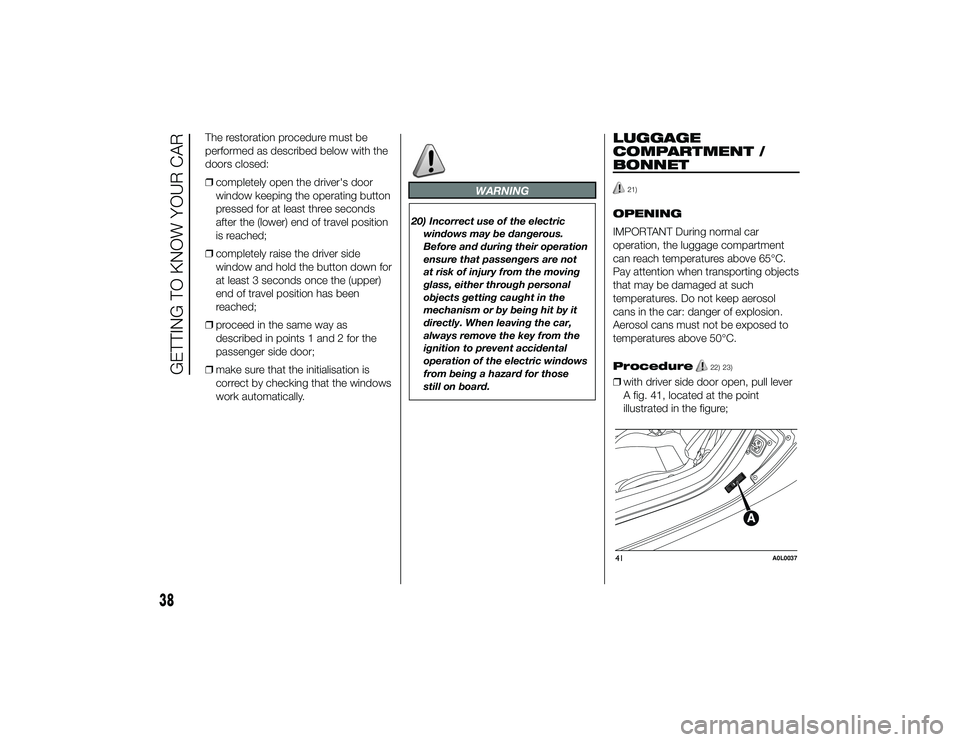
The restoration procedure must be
performed as described below with the
doors closed:
❒completely open the driver's door
window keeping the operating button
pressed for at least three seconds
after the (lower) end of travel position
is reached;
❒ completely raise the driver side
window and hold the button down for
at least 3 seconds once the (upper)
end of travel position has been
reached;
❒ proceed in the same way as
described in points 1 and 2 for the
passenger side door;
❒ make sure that the initialisation is
correct by checking that the windows
work automatically.
WARNING
20) Incorrect use of the electric
windows may be dangerous.
Before and during their operation
ensure that passengers are not
at risk of injury from the moving
glass, either through personal
objects getting caught in the
mechanism or by being hit by it
directly. When leaving the car,
always remove the key from the
ignition to prevent accidental
operation of the electric windows
from being a hazard for those
still on board.
LUGGAGE
COMPARTMENT /
BONNET
21)
OPENING
IMPORTANT During normal car
operation, the luggage compartment
can reach temperatures above 65°C.
Pay attention when transporting objects
that may be damaged at such
temperatures. Do not keep aerosol
cans in the car: danger of explosion.
Aerosol cans must not be exposed to
temperatures above 50°C.
Procedure
22) 23)
❒with driver side door open, pull lever
A fig. 41, located at the point
illustrated in the figure;41
A0L0037
38
GETTING TO KNOW YOUR CAR
24-9-2013 11:49 Pagina 38
Page 42 of 190
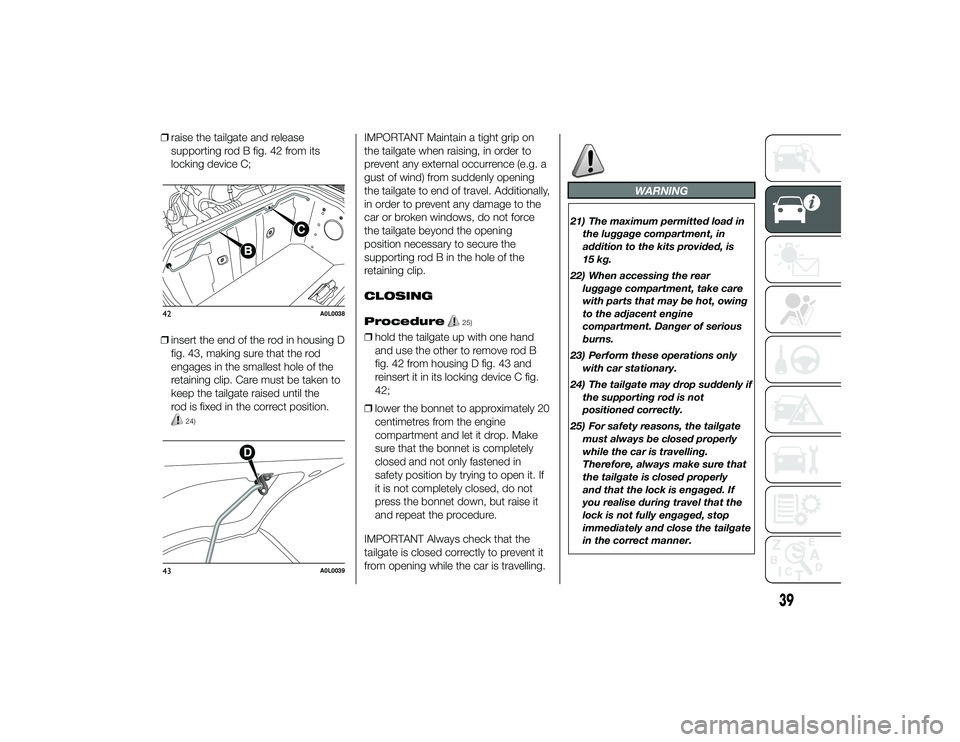
❒raise the tailgate and release
supporting rod B fig. 42 from its
locking device C;
❒ insert the end of the rod in housing D
fig. 43, making sure that the rod
engages in the smallest hole of the
retaining clip. Care must be taken to
keep the tailgate raised until the
rod is fixed in the correct position.
24)
IMPORTANT Maintain a tight grip on
the tailgate when raising, in order to
prevent any external occurrence (e.g. a
gust of wind) from suddenly opening
the tailgate to end of travel. Additionally,
in order to prevent any damage to the
car or broken windows, do not force
the tailgate beyond the opening
position necessary to secure the
supporting rod B in the hole of the
retaining clip.
CLOSING
Procedure
25)
❒hold the tailgate up with one hand
and use the other to remove rod B
fig. 42 from housing D fig. 43 and
reinsert it in its locking device C fig.
42;
❒ lower the bonnet to approximately 20
centimetres from the engine
compartment and let it drop. Make
sure that the bonnet is completely
closed and not only fastened in
safety position by trying to open it. If
it is not completely closed, do not
press the bonnet down, but raise it
and repeat the procedure.
IMPORTANT Always check that the
tailgate is closed correctly to prevent it
from opening while the car is travelling.
WARNING
21) The maximum permitted load in the luggage compartment, in
addition to the kits provided, is
15 kg.
22) When accessing the rear luggage compartment, take care
with parts that may be hot, owing
to the adjacent engine
compartment. Danger of serious
burns.
23) Perform these operations only with car stationary.
24) The tailgate may drop suddenly if the supporting rod is not
positioned correctly.
25) For safety reasons, the tailgate must always be closed properly
while the car is travelling.
Therefore, always make sure that
the tailgate is closed properly
and that the lock is engaged. If
you realise during travel that the
lock is not fully engaged, stop
immediately and close the tailgate
in the correct manner.
42
A0L0038
43
A0L0039
39
24-9-2013 11:49 Pagina 39
Page 45 of 190
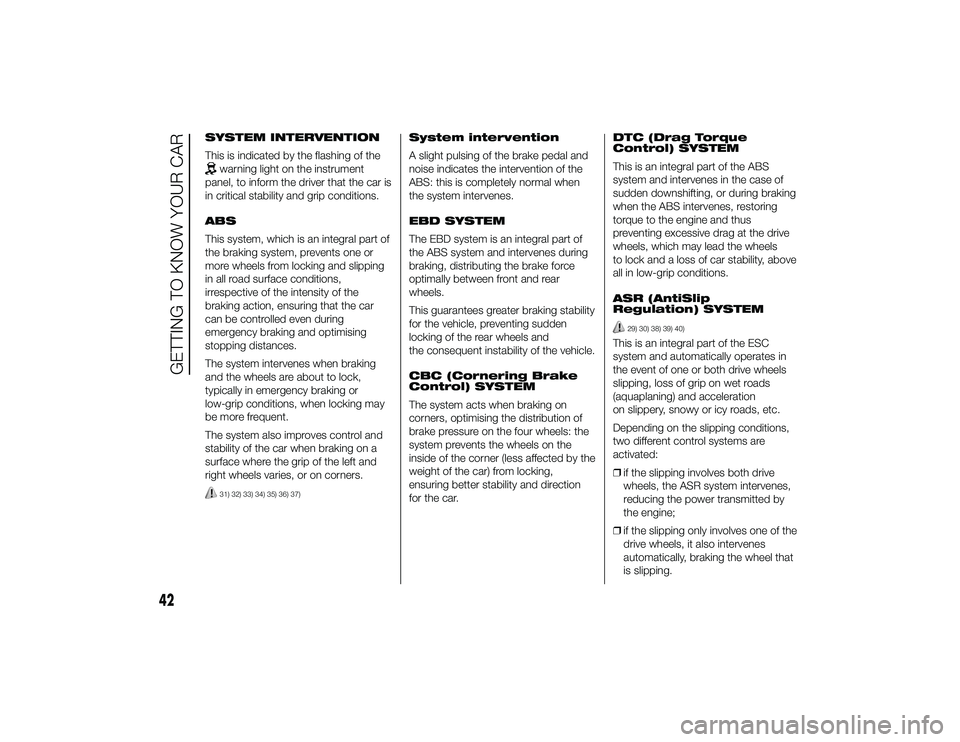
SYSTEM INTERVENTION
This is indicated by the flashing of the
warning light on the instrument
panel, to inform the driver that the car is
in critical stability and grip conditions.
ABS
This system, which is an integral part of
the braking system, prevents one or
more wheels from locking and slipping
in all road surface conditions,
irrespective of the intensity of the
braking action, ensuring that the car
can be controlled even during
emergency braking and optimising
stopping distances.
The system intervenes when braking
and the wheels are about to lock,
typically in emergency braking or
low-grip conditions, when locking may
be more frequent.
The system also improves control and
stability of the car when braking on a
surface where the grip of the left and
right wheels varies, or on corners.31) 32) 33) 34) 35) 36) 37)
System intervention
A slight pulsing of the brake pedal and
noise indicates the intervention of the
ABS: this is completely normal when
the system intervenes.
EBD SYSTEM
The EBD system is an integral part of
the ABS system and intervenes during
braking, distributing the brake force
optimally between front and rear
wheels.
This guarantees greater braking stability
for the vehicle, preventing sudden
locking of the rear wheels and
the consequent instability of the vehicle.
CBC (Cornering Brake
Control) SYSTEM
The system acts when braking on
corners, optimising the distribution of
brake pressure on the four wheels: the
system prevents the wheels on the
inside of the corner (less affected by the
weight of the car) from locking,
ensuring better stability and direction
for the car. DTC (Drag Torque
Control) SYSTEM
This is an integral part of the ABS
system and intervenes in the case of
sudden downshifting, or during braking
when the ABS intervenes, restoring
torque to the engine and thus
preventing excessive drag at the drive
wheels, which may lead the wheels
to lock and a loss of car stability, above
all in low-grip conditions.
ASR (AntiSlip
Regulation) SYSTEM
29) 30) 38) 39) 40)
This is an integral part of the ESC
system and automatically operates in
the event of one or both drive wheels
slipping, loss of grip on wet roads
(aquaplaning) and acceleration
on slippery, snowy or icy roads, etc.
Depending on the slipping conditions,
two different control systems are
activated:
❒
if the slipping involves both drive
wheels, the ASR system intervenes,
reducing the power transmitted by
the engine;
❒ if the slipping only involves one of the
drive wheels, it also intervenes
automatically, braking the wheel that
is slipping.
42
GETTING TO KNOW YOUR CAR
24-9-2013 11:49 Pagina 42
Page 46 of 190
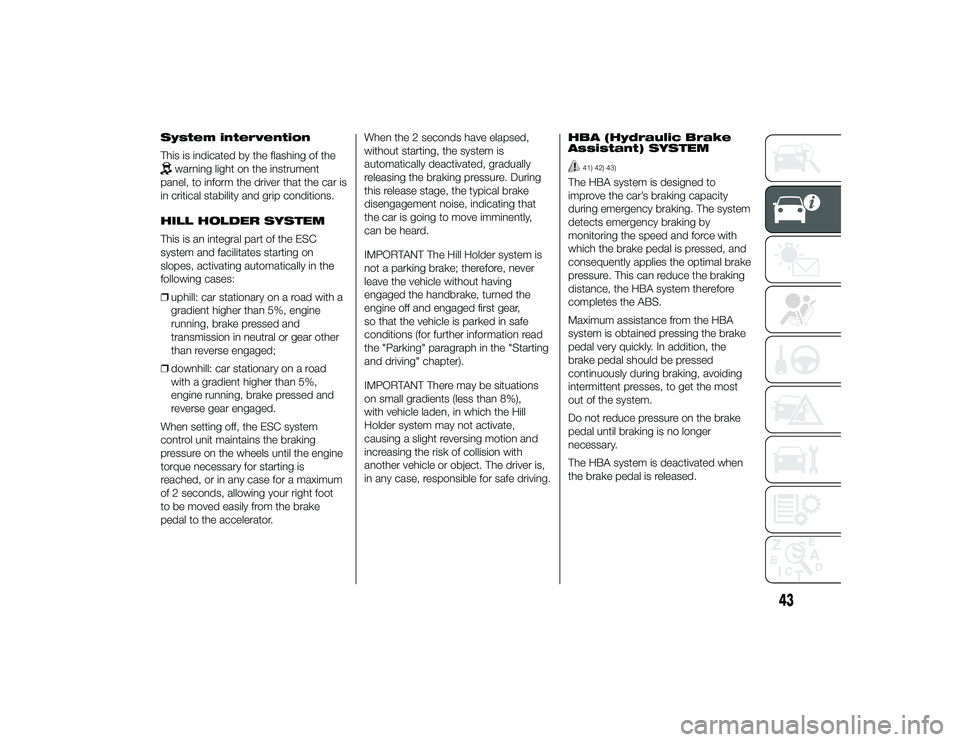
System intervention
This is indicated by the flashing of the
warning light on the instrument
panel, to inform the driver that the car is
in critical stability and grip conditions.
HILL HOLDER SYSTEM
This is an integral part of the ESC
system and facilitates starting on
slopes, activating automatically in the
following cases:
❒ uphill: car stationary on a road with a
gradient higher than 5%, engine
running, brake pressed and
transmission in neutral or gear other
than reverse engaged;
❒ downhill: car stationary on a road
with a gradient higher than 5%,
engine running, brake pressed and
reverse gear engaged.
When setting off, the ESC system
control unit maintains the braking
pressure on the wheels until the engine
torque necessary for starting is
reached, or in any case for a maximum
of 2 seconds, allowing your right foot
to be moved easily from the brake
pedal to the accelerator. When the 2 seconds have elapsed,
without starting, the system is
automatically deactivated, gradually
releasing the braking pressure. During
this release stage, the typical brake
disengagement noise, indicating that
the car is going to move imminently,
can be heard.
IMPORTANT The Hill Holder system is
not a parking brake; therefore, never
leave the vehicle without having
engaged the handbrake, turned the
engine off and engaged first gear,
so that the vehicle is parked in safe
conditions (for further information read
the "Parking" paragraph in the "Starting
and driving" chapter).
IMPORTANT There may be situations
on small gradients (less than 8%),
with vehicle laden, in which the Hill
Holder system may not activate,
causing a slight reversing motion and
increasing the risk of collision with
another vehicle or object. The driver is,
in any case, responsible for safe driving.
HBA (Hydraulic Brake
Assistant) SYSTEM
41) 42) 43)
The HBA system is designed to
improve the car’s braking capacity
during emergency braking. The system
detects emergency braking by
monitoring the speed and force with
which the brake pedal is pressed, and
consequently applies the optimal brake
pressure. This can reduce the braking
distance, the HBA system therefore
completes the ABS.
Maximum assistance from the HBA
system is obtained pressing the brake
pedal very quickly. In addition, the
brake pedal should be pressed
continuously during braking, avoiding
intermittent presses, to get the most
out of the system.
Do not reduce pressure on the brake
pedal until braking is no longer
necessary.
The HBA system is deactivated when
the brake pedal is released.
43
24-9-2013 11:49 Pagina 43
Page 47 of 190
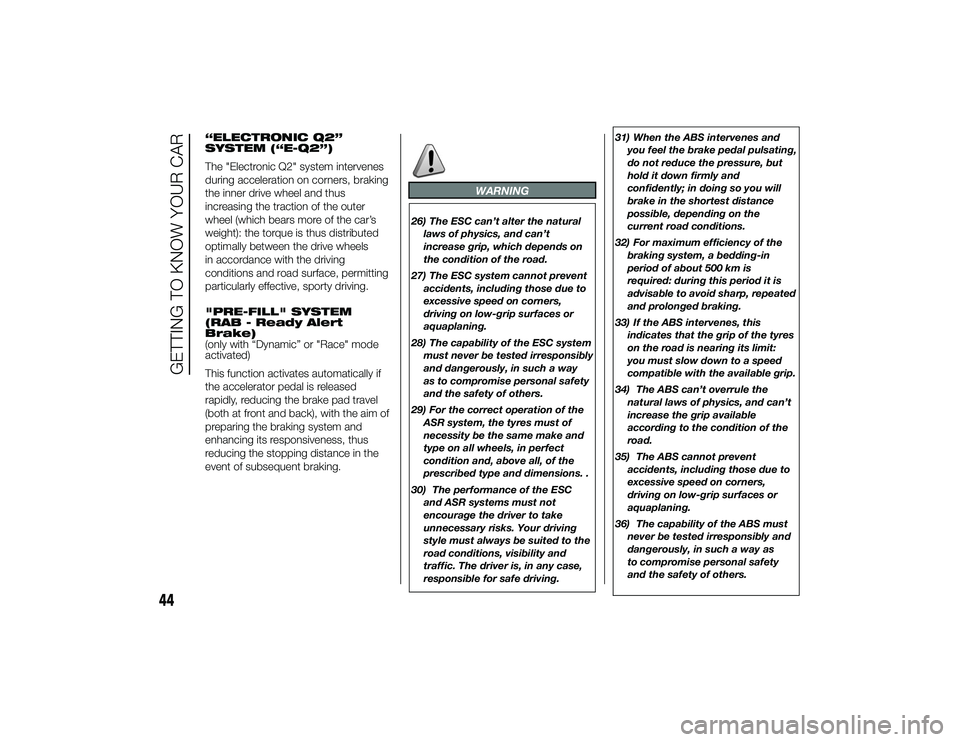
“ELECTRONIC Q2”
SYSTEM (“E-Q2”)
The "Electronic Q2" system intervenes
during acceleration on corners, braking
the inner drive wheel and thus
increasing the traction of the outer
wheel (which bears more of the car’s
weight): the torque is thus distributed
optimally between the drive wheels
in accordance with the driving
conditions and road surface, permitting
particularly effective, sporty driving.
"PRE-FILL" SYSTEM
(RAB - Ready Alert
Brake)
(only with “Dynamic” or "Race" mode
activated)
This function activates automatically if
the accelerator pedal is released
rapidly, reducing the brake pad travel
(both at front and back), with the aim of
preparing the braking system and
enhancing its responsiveness, thus
reducing the stopping distance in the
event of subsequent braking.
WARNING
26) The ESC can’t alter the naturallaws of physics, and can’t
increase grip, which depends on
the condition of the road.
27) The ESC system cannot prevent accidents, including those due to
excessive speed on corners,
driving on low-grip surfaces or
aquaplaning.
28) The capability of the ESC system must never be tested irresponsibly
and dangerously, in such a way
as to compromise personal safety
and the safety of others.
29) For the correct operation of the ASR system, the tyres must of
necessity be the same make and
type on all wheels, in perfect
condition and, above all, of the
prescribed type and dimensions. .
30) The performance of the ESC and ASR systems must not
encourage the driver to take
unnecessary risks. Your driving
style must always be suited to the
road conditions, visibility and
traffic. The driver is, in any case,
responsible for safe driving. 31) When the ABS intervenes and
you feel the brake pedal pulsating,
do not reduce the pressure, but
hold it down firmly and
confidently; in doing so you will
brake in the shortest distance
possible, depending on the
current road conditions.
32) For maximum efficiency of the braking system, a bedding-in
period of about 500 km is
required: during this period it is
advisable to avoid sharp, repeated
and prolonged braking.
33) If the ABS intervenes, this indicates that the grip of the tyres
on the road is nearing its limit:
you must slow down to a speed
compatible with the available grip.
34) The ABS can’t overrule the natural laws of physics, and can’t
increase the grip available
according to the condition of the
road.
35) The ABS cannot prevent accidents, including those due to
excessive speed on corners,
driving on low-grip surfaces or
aquaplaning.
36) The capability of the ABS must never be tested irresponsibly and
dangerously, in such a way as
to compromise personal safety
and the safety of others.
44
GETTING TO KNOW YOUR CAR
24-9-2013 11:49 Pagina 44
Page 51 of 190

Deactivation
To deactivate “All Weather” mode and
return to “Natural”, move lever A fig. 47
upwards (to letter “d”) and keep it in
this position for half a second.
IMPORTANT
❒When the engine is next started, the
"All Weather" or "Dynamic" mode
selected previously is retained. The
system will reactivate in "All Weather"
or "Dynamic" mode, depending on
which mode was selected before the
engine was switched off.
❒ When the engine is next started, the
"Race" mode selected previously is
not retained. The system will
reactivate in "Dynamic" mode.
❒ It is not possible to go directly from
“Dynamic” mode to “All Weather”
mode and vice versa. You must
always first go back to “Natural”
mode and then select the other
mode.
System failure
In the event of system failure or a fault
with lever A fig. 47, no driving modes
can be selected. The display will become grey (same
screen as "Natural" mode) but without
an indication of the Alfa DNA setting.
The display will also show a warning
message.
EOBD SYSTEM
(European On
Board Diagnosis)Operation
The EOBD system (European On Board
Diagnosis) carries out a continuous
diagnosis of the components of the car
related to emissions.
It also alerts the driver, by switching on
the
warning light on the instrument
panel, together with a message on
the display, when these components
are no longer in peak condition (see
“Warning lights and messages”
paragraph in the "Knowing the
instrument panel" chapter).
The aim of the EOBD system (European
On Board Diagnosis) is to:
❒ monitor the efficiency of the system;
❒ indicate an increase in emissions;
❒ indicate the need to replace
deteriorated components.
48
GETTING TO KNOW YOUR CAR
24-9-2013 11:49 Pagina 48
Page 53 of 190

Fiat Group Automobiles S.p.A.
authorises the installation of transceiver
devices on condition that such
installations are carried out in
a workmanlike fashion, following the
manufacturer’s instructions, at a
specialised centre.
IMPORTANT Traffic police may not
allow the car on the road if devices
have been installed which modify the
features of the car. This may also cause
invalidation of warranty in relation to
faults caused by the change either
directly or indirectly related to it.
Fiat Group Automobiles S.p.A. shall not
be liable for damage caused by the
installation of accessories either not
supplied or recommended by Fiat
Group Automobiles S.p.A. and/or not
installed in compliance with the
provided instructions.
RADIO TRANSMITTERS
AND MOBILE PHONES
Radio transmitter equipment (vehicle
mobile phones, CB radios, amateur
radio etc.) cannot be used inside the
car unless a separate aerial is mounted
on the roof.IMPORTANT The use of these devices
inside the passenger compartment
(without a separate aerial) may cause
the vehicle’s electronic systems to
malfunction. This could compromise
safety in addition to constituting a
potential hazard for passengers' health.
As far as the use of EC-approved
mobile phones is concerned (GSM,
GPRS, UMTS), follow the usage
instructions provided by the mobile
phone manufacturer.
WARNING
44) Take care when fitting additional
spoilers or non-standard alloy
wheels: they could reduce the
ventilation of the brakes and
affect efficiency in sharp,
repeated braking or on long
descents. Make sure that nothing
obstructs the pedal stroke (mats,
etc.).
PARKING SENSORS(for versions/markets, where provided)
They are located in the rear bumper
fig. 53 and their function is to detect the
presence of any obstacles near the
rear part of the car; they consequently
inform the driver, through an
intermittent acoustic signal.
ACTIVATION/
DEACTIVATION
The sensors are automatically activated
when reverse gear is engaged. As the
obstacle behind the car gets closer, the
acoustic signal becomes more
frequent.53
A0L0043
50
GETTING TO KNOW YOUR CAR
24-9-2013 11:49 Pagina 50
Page 54 of 190

ACOUSTIC SIGNAL
When reverse gear is engaged and
there is an obstacle behind the vehicle,
an acoustic signal is emitted which
varies according to the distance of the
bumper from the obstacle.
The frequency of the acoustic signal:
❒increases as the distance between
car and obstacle decreases,
culminating in a continuous acoustic
signal, when the distance is less
than approximately 30 cm;
❒ decreases if the distance from the
obstacle increases, until the signal
ceases entirely;
❒ remains constant if the distance
between car and obstacle remains
unchanged; if this situation concerns
the side sensors, the signal will
stop after approximately 3 seconds
to avoid, for example, indications
in the event of manoeuvres along a
wall.
If several obstacles are detected by the
sensors, only the nearest one is
considered. INDICATIONS ON
DISPLAY
(for versions/markets, where provided)
When the sensors are activated, the
screen in fig. 54 appears on the display.
Obstacle presence and distance
information is therefore provided both
by the acoustic signal and the
instrument panel display.
The system indicates a detected
obstacle by displaying an arc in one or
more positions according to the
distance of the obstacle and its position
in relation to the car.
If an obstacle is detected in the rear
central area, the display shows all the
arcs in the rear central area, up to
the one that corresponds to the
position of the obstacle itself.The signal is similar for obstacles in the
rear left or right area.
The arc that corresponds to the
position of the obstacle will flash.
The colour on the display depends on
the distance from and position of the
obstacle.
The car is close to the obstacle when
the display shows a single constant arc
and emits a continuous sound.
If there are several obstacles, the
closest one is indicated.
FAULT INDICATION
Parking sensor failures, if any, will be
indicated when reverse is engaged by
the switching on of the
warning
light on the instrument panel together
with the message on the display (see
“Warning lights and messages”
chapter).
GENERAL WARNINGS
45)4)
When parking, take the utmost care
over obstacles that may be above
or under the sensor.
54
A0L0044
51
24-9-2013 11:49 Pagina 51
Page 55 of 190

Under certain circumstances, objects
close to the vehicle are not detected by
the system and could therefore cause
damage to the car or be damaged
themselves.
Some conditions may influence the
performance of the parking sensors:
❒the presence of ice, snow, mud
or multiple layers of paint on the
sensor surface may cause reduced
sensitivity of the sensor itself and
therefore reduce the system
performance;
❒ mechanical interference (e.g. washing
the car, rain, strong wind, hail) may
cause the sensor to detect a
non-existent obstacle ("echo
interference");
❒ the presence of ultrasonic systems
(e.g. pneumatic brake systems of
trucks or pneumatic drills) near the
car could alter the signals sent by the
sensor;
❒ the variation in sensor position,
caused by variation in ride (due
to suspension component wear),
changing tyres, overloaded car,
or tuning that lowers the car, for
example, may affect parking sensor
system performance.
WARNING
45) The responsibility for parking
and other dangerous manoeuvres
always and in every case lies
with the driver. While carrying out
these manoeuvres, always make
sure that no people (especially
children) or animals are in the
area concerned. The parking
sensors are an aid for the driver,
but must never allow their
attention to lapse during
potentially dangerous
manoeuvres, even those executed
at low speeds.
IMPORTANT
4) The sensor must be free frommud, dirt, snow or ice in order for
the system to operate correctly.
Be careful not to scratch or
damage the sensors while
cleaning them. Avoid using dry,
rough or hard cloths. The sensors
must be washed using clean
water, with the addition of car
shampoo if necessary. When
using special washing equipment
such as high pressure jets or
steam cleaning, clean the sensors
very quickly keeping the jet more
than 10 cm away. Also, do not
apply stickers to the sensors.
52
GETTING TO KNOW YOUR CAR
24-9-2013 11:49 Pagina 52
Page 56 of 190

TPMS (Tyre
Pressure
Monitoring System)(for versions/markets, where provided)
The car can be equipped with a tyre
pressure monitoring system (TPMS),
which informs the driver of the tyre
inflation status via dedicated messages
on the display fig. 55.
The system comprises a radio-
frequency transmitter sensor fitted to
each wheel (on the rim inside the tyre),
which is able to send information on the
inflation pressure of each tyre to the
control unit.IMPORTANT
INFORMATION ABOUT
THE TPMS
46) 47) 48) 49) 50) 51) 52) 53) 54)
The fault indications are not stored and
will therefore not be displayed after
the engine has been switched off and
then on again.
If the fault conditions persist, the control
unit will send the relative indications to
the instrument panel only after the
car has been in motion for a short time.
TPMS FAILURE
In the event of TPMS failure, dashes will
be displayed instead of the tyre
pressure status together with the
activation of the dedicated
warning
light (see "Warning lights and
messages" section in the"Knowing the
instrument panel" chapter). To restore
correct operation of the system,
contact a dedicated Alfa Romeo
Dealership.
55
A0L0113
53
24-9-2013 11:49 Pagina 53